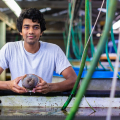Our lab addresses the question of how complex traits originate during evolution. We primarily study invertebrate visual systems and eyes, addressing questions like, when did a particular phenotype evolve? When did the components of that phenotype evolve? Where did those components come from? What evolutionary processes and mechanisms were involved?







